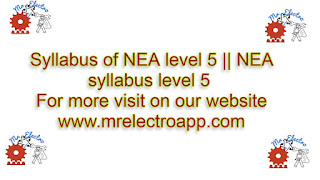Syllabus of NEA level 5 || NEA syllabus level 5
This is the Syllabus of NEA level 5 || NEA syllabus level 5 || NEA post for supervisor loksewa exam for free quota(khulla quota). This is taken from NEA official website to help others. If you are searching for NEA loksewa aayog syllabus you can mail us for all level like level 3, level 4, level 5, level 7 and other more. We will send to your mail. The NEA syllabus level 5 is given below.
1. FUNDAMENTALS [5x2=10, 2x5=10]
Concept of resistance, inductance, capacitance and their role in electric circuits.
Series and parallel connection of resistance, inductance and capacitance.
Ohm’s law and Kirchhoff’s law.
Alternating current fundamentals: Faraday’s laws of electromagnetic induction, generation of
alternating voltages and currents and their equations and waveforms, amplitude, frequency, phase,
phase difference, average and rms values, A.C. through resistance, inductance, capacitance and
through their combinations, single phase and three phase AC systems.
Heating effect of electric current
General norms of system voltage regulation and frequency regulation.
2. POWER PLANTS [2x2=4, 1x10=10]
Hydroelectric power plants: Merits and demerits, classifications and respective layouts, selection
of sites, types of water turbines, their working principles and applications.
Diesel electric power plants: Merits and demerits, selection of sites, elements of a diesel plant and
its layout.
Non conventional power generation: Photo voltaic or solar cells, solar power generation, wind
power generation.
Base load power plants, peak load power plant
Plant capacity factor, plant utilization factor, reserve required and types
3. LECTRICAL MACHINES [4x2=8, 1x5=5, 1x10=10]
D.C. generators: Working principle, types of D.C. generators, external, internal and no load
characteristics, losses and efficiency.
D.C. motors: Working principle, types of D.C. motors, characteristics of D.C. series and shunt
motors, losses and efficiency
Synchronous generator: Working principle, equation of induced E.M.F., short circuit and open
circuit characteristics, voltage regulation, losses and efficiency, parallel operation and
synchronizing, Alternators connected to infinite bus bars, different types of excitation systems,
drying of alternators.
Three phase induction motors: Working principle, squirrel cage and slip ring motors,
characteristic of induction motors, starting torque ant torque under running condition, starting of
induction motors.
Transformers: Working principle, E.M.F. equation, transformer at no load and at loaded
condition, losses and efficiency, parallel operation, different components of transformers,
transformer oil and its role, cooling of transformers, Bucholtz protection.
Auto transformer.
Three phase transformers in parallel operation.
No-load and full load test of transformers.
Prerequisites for starting of generators in hydro and diesel station.
Necessity of cooling in power stations
Role of auxiliary equipments in power stations, storage batteries, their capacities, charging and
maintenance.
Concept of black start units in power stations.
See more in the given pdf below.....







Nice
ReplyDelete